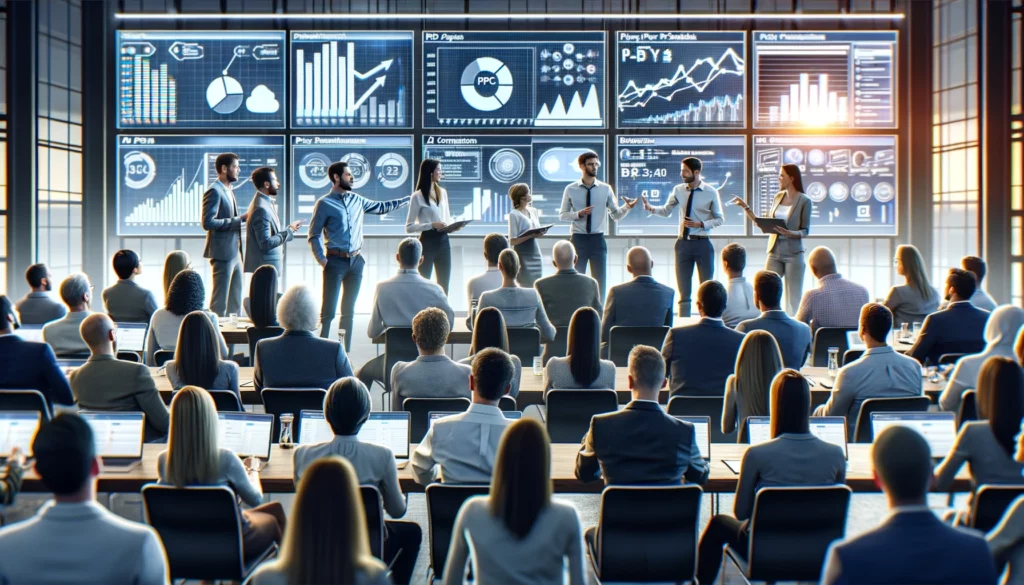

Last updated on

Within SEJ’s PPC Trends 2024 ebook, an annual compilation of expert forecasts for the upcoming year, significant advancements in AI features across PPC platforms have been observed, accompanied by a notable uptake of generative AI among marketers.
As the initial excitement surrounding AI settles, a more nuanced and cautious perspective is emerging among industry experts. Contributors underscore the advantages of leveraging AI-driven automated ad campaigns and integrating generative AI into workflows, while also issuing reminders about the irreplaceable role of human cognition and creativity in online interactions.
In essence, these insights can be distilled into three key points: AI excels within its domain but falters outside it; caution is advised to avoid misapplications of AI, recognizing that it isn’t a universal solution; and while AI holds potential to enhance productivity and outcomes, the value of certain human-driven processes should not be overlooked despite their challenges.

Founder of AKvertise, Akvile DeFazio, underscores the rapidly growing significance of Artificial Intelligence (AI) within the advertising sector. This transformative technology is reshaping the landscape by revolutionizing how businesses engage with their desired demographics and empowering advertisers to enhance the efficacy and streamline the management of ad campaigns.
Highlighted below are several avenues through which AI is poised to deliver heightened outcomes in the year 2024.
Creative Optimization
In just a few years, the landscape of campaign and ad set configurations has evolved significantly, particularly in response to iOS updates. Meta’s introduction of various machine learning features has provided advertisers with powerful tools to enhance targeting precision and achieve superior outcomes.
Within Meta Ads Manager, the advent of Advantage+ Audiences represents a notable advancement. Leveraging machine learning capabilities, advertisers can swiftly pinpoint the most valuable audience segments. By activating this feature, advertisers can also propose audience suggestions, such as recent purchasers. This prompts the system to prioritize individuals matching this high-value profile, thereby refining targeting efforts before expanding outreach to broader demographics.
For ecommerce professionals, Meta’s Advantage+ shopping campaigns offer a compelling solution. Through automatic placements, lowest-cost bid strategies, and other AI-driven functionalities, these campaigns excel at identifying new customer prospects. By serving tailored ads to individuals with the highest likelihood of conversion, Meta’s AI algorithms optimize campaign performance and maximize ROI.
Measuring Results
AI also delivers robust analytics and reporting functionalities, empowering advertisers to accurately gauge the performance of their campaigns. Through data-driven insights, advertisers can discern the most successful ads and targeting approaches, facilitating informed decisions for campaign optimization.
Utilizing tools that facilitate data importation, trend analysis, graph creation, and insight extraction, advertisers can derive valuable information to inform their strategies.
By streamlining the reporting and analysis processes, AI-powered tools serve as invaluable time-saving assets, guiding optimization endeavors and driving favorable results.
This represents just the initial phase of the AI revolution reshaping the social media advertising arena. Brands now possess the capability to engage with their target audience in more impactful ways, thereby achieving diverse objectives.
Embracing experimentation with AI yields significant benefits, enhancing human capabilities and augmenting efficiency, productivity, and effectiveness in advertising endeavors.
If you haven’t already, integrating AI into your advertising toolkit is essential for propelling growth initiatives in 2024.

As Founder and CEO of Your Digital Assembly, Alex Macura reflects on the ever-accelerating pace of the world, particularly within the dynamic realm of marketing.
In the past half-century, we’ve witnessed remarkable growth across various marketing domains, including digital marketing, social media, mobile marketing, television advertising, and database marketing.
However, what lies ahead for the industry, particularly in the year 2024? Let’s delve into the future trajectory of marketing.
A Surge In AI Marketing
AI empowers marketers with the remarkable capability to swiftly analyze vast volumes of data, significantly enhancing efficiency and productivity in campaign management.
Through predictive analytics, AI enables the anticipation of consumer behaviors and purchase patterns, facilitating the creation of tailored and targeted ad campaigns.
Furthermore, AI systems continually evolve and learn over time, refining their capabilities and becoming increasingly adept at their tasks. Therefore, for those who have hesitated to embrace AI, the time has come to embrace this transformative technology and leverage its potential to elevate marketing strategies.
More Personalized Content
AI’s prowess extends to another domain: personalization. In the year 2024, hyper-personalization emerges as the forthcoming norm.
Consumers seek recognition, thus, brands investing effort into crafting bespoke purchasing journeys will garner favor.
Leveraging AI alongside sophisticated analytics, content attains unprecedented levels of customization, fostering stronger brand connections and enhancing return on investment (ROI).

Amy Hebdon, Founder and Managing Director of Paid Search Magic, emphasizes the potential of generative AI to enhance campaigns, cautioning against two common pitfalls:
Acknowledging that generative AI is still developing and prone to errors, complete reliance on it for flawless accuracy is unwise.
However, dismissing it entirely due to its limitations deprives oneself of opportunities for creativity and productivity.
Between these extremes lies a multitude of possibilities to enhance and streamline work processes. Generative AI can be utilized for tasks such as discovery, challenging assumptions, brainstorming, iterating and refining ideas, editing, and strategy development.
Starting with accessible tools like the free version of ChatGPT can significantly enhance work and workflow without the need for expensive subscriptions.

Andrea Atzori, Director at Ambire, highlights the transformative role of automation in optimizing routine tasks within our operations, particularly in campaign construction and reporting.
By integrating automation, we not only accelerate these processes significantly but also reduce the risk of human errors.
However, it’s crucial to recognize that while AI and machine learning (ML) innovations offer immense potential, they also pose a risk of standardizing content, often resulting in outcomes that are merely satisfactory or average.
To achieve marketing excellence rather than settling for mediocrity, it’s imperative to harness the full spectrum of available data and tools.
Only by embracing this comprehensive approach can we effectively manage costs and consistently deliver exceptional results.

Ben Wood, Growth & Innovation Director at Hallam, has long recognized the burgeoning influence of machine learning and automation in the realm of advertising.
Throughout 2023, there was a marked surge in technological advancements, notably seen in the democratization of creative production through the integration of generative AI tools within platforms like Google Ads. This integration has not only slashed costs but also expedited the production process, making platforms such as YouTube and display formats more accessible to smaller advertisers with limited budgets.
Moreover, the spotlight was on the significant strides made in large language models (LLMs), empowering advertisers to develop scripts with minimal programming knowledge and offering substantial efficiencies in campaign creation and PPC account expansion.
Looking ahead to 2024, the focus will shift to the secondary effects of generative AI. These encompass the subtler, longer-term consequences induced by AI.
Despite the ability to generate ads at scale using generative AI, there’s a looming concern that this might not necessarily translate to improved performance. AI, proficient in mass-producing ads like automatically generated ads and demand generation features in Performance Max, might inadvertently inundate users with an excess of generic, feature-centric ads. Consequently, there’s a risk that consumers will become desensitized to these ads, ultimately diminishing their effectiveness.
Increased Value On Human Perspectives And Creators
As people become adept at filtering out the repetitive advertising produced by generative AI, there will be a growing demand for authentic human viewpoints and originality.
Google has already taken steps in this direction by highlighting creators and influencers through their “perspectives” feature within the Search Generative Experience. This trend is likely to extend into the realm of advertising.
In the upcoming year, collaborating with consumer-facing creators and influencers will become increasingly vital for your paid media strategy. This approach will be crucial for maximizing your visibility across Google’s dynamic search environment and other platforms.
Back To Basics: Creative-First Advertising
In the midst of managing numerous channels, maintaining cohesion can be challenging. What serves as the glue? A creative spark.
Without a cohesive, enduring creative concept, your campaigns are likely to falter.
At times, we become so engrossed in selecting platforms that we lose sight of the core message we aim to convey through them.
As generative AI gains prominence, I believe creativity will emerge as a pivotal factor for campaign success. It’s imperative to begin with a strategic foundation, prioritizing creative ideation before delving into media planning.
This acts as a guiding thread—a captivating creative notion that unifies all your marketing and advertising endeavors, setting you apart in the competitive landscape.

Corey Morris, President/CEO of Voltage, emphasizes that AI-generated content is here to stay and is increasingly integrated into AI-driven advertising campaigns in 2024.
Utilizing AI, businesses can generate descriptions, headlines, and ad copy precisely aligned with their clients’ campaign goals, leading to impactful and personalized content.
This level of personalization is achievable as AI comprehends user behavior patterns and employs ongoing experimentation, swiftly adapting successful strategies to campaigns in real-time.
With the ability to monitor and optimize campaign performance in real-time, agencies can ensure that their clients’ campaigns are consistently meeting their objectives.
Performance Max Campaigns
In 2024, Performance Max campaigns will leverage machine learning and artificial intelligence technology to a greater extent.
These campaigns, which come after search campaigns, are widely regarded as one of the most efficient methods to expand audience reach and enhance return on investment.
Google has introduced the option to upgrade different types of campaigns, such as dynamic search ads and display campaigns, to Performance Max campaigns.
Transitioning to Performance Max campaigns offers several immediate advantages, including:
Performance Max campaigns leverage your creative assets to optimize search ads, ensuring they align with the preferences and search queries of your target audience. This flexibility allows for dynamic adjustments to ad copy text, maximizing relevance and effectiveness.
By connecting your product data feed to a Performance Max campaign, ads are tailored based on your available inventory. This automation eliminates the need for manual monitoring of product stock levels, saving valuable time and effort.
These advancements in Performance Max campaigns are expected to drive increased adoption among advertisers, thanks to their ability to streamline ad creation, improve relevance, and optimize inventory management.

Tim Jensen, Senior Specialist in Search Marketing at M&T Bank, emphasizes the importance of staying connected with clients or supervisors to grasp their concerns and objectives fully. In an era where automated campaign solutions are prevalent, it’s essential not to overlook the significance of understanding stakeholders’ needs.
While keeping pace with the latest functionalities of advertising platforms remains crucial, there’s a risk of succumbing to a “plug-and-play” mindset due to the increasing automation in the PPC landscape.
Though configuring a conversion pixel is now relatively straightforward in many instances, it’s vital to introspect on the purpose behind tracking that conversion and how it aligns with the broader business objectives that the company prioritizes.
Utilizing AI to generate 15 responsive search ad headlines undoubtedly streamlines the process, yet the question remains: will they truly resonate on the search engine results page (SERP) when compared to meticulously crafted headlines that genuinely address the customer’s needs?
While generating a keyword list has become increasingly straightforward with tools like Keyword Planner, it prompts us to ponder whether those keywords truly encapsulate what our ideal customers are searching for.
Nevertheless, the proliferation of automation within platforms brings about advantages, notably in reducing the necessity for constant manual adjustments like bid management. This newfound efficiency affords marketers more time to focus on nurturing relationships with stakeholders.
As we step into 2024, it’s paramount to dedicate thoughtful consideration to understanding stakeholder objectives. Aligning targeting, creative content, and bidding strategies with these objectives is key to delivering impactful outcomes.

Lauren Weisel, the Director of SEM at Media.Monks, delves into the topic of AI’s impact on PPC, discussing its potential and limitations.
A prominent theme throughout 2023 has been the increasing reliance on automation, a trend that is expected to persist well into 2024.
Google has been at the forefront of this movement, introducing campaign types characterized by heavy automation and reduced control for marketers. This trend began with Performance Max and has continued with the recent launch of Demand Gen.
As Performance Max has matured, numerous instances demonstrate its effectiveness as an automated campaign type.
With the recent introduction of Demand Gen campaigns, it’s anticipated that Google will further expand the coverage of these campaigns or introduce additional automated campaign types in the future.
With Google’s continued focus on automated campaign types, I anticipate a corresponding rise in the percentage of account spends allocated to these campaigns. Looking ahead, the possibilities are vast and unpredictable.
There’s speculation about a future where traditional search campaigns, as we currently understand them, might eventually fade away. However, this remains conjecture at this stage.
Regarding traditional search campaigns, there’s been a noticeable shift towards reduced control, particularly with the promotion of broad match with auto-bidding.
Despite initial skepticism from clients, this new match type has proven to be highly effective for many advertisers. Concurrently, there’s been a decrease in account spend allocated to phrase match keywords, often without any adverse effects on performance.
This evolution in match types has also prompted a reevaluation of account structures, leading to a trend of campaign consolidation, departing from the Single Keyword Ad Group (SKAG) structure commonly taught in the early stages of my career.
The diminishing control advertisers face within Google will inevitably reshape the approach of search marketers. Yet, reflecting on my journey in this field, I recall significant industry shifts that initially appeared daunting but ultimately enabled me to diversify my skill set.
I vividly recall the emergence of auto-bidding strategies. The prospect of liberating my time from daily bid adjustments was both exhilarating and uncertain. However, as automation matured, it prompted a reevaluation of how we allocated our time as marketers. Fortunately, there was no shortage of tasks to fill the void.
As Google Ads undergoes further evolution, imposing limitations on control, search marketers must embrace creativity to devise strategies that propel search programs forward using the available levers.
Approaching automated campaigns with a “set it and forget it” mentality is not advisable. It’s crucial to recognize the privilege of educating clients and guiding them through the dynamic landscape of search. The near future promises abundant opportunities for testing and learning.
Undoubtedly, the search landscape has undergone significant transformations, particularly in the past year. While the prevalence of automation might evoke apprehension, embracing it is essential for staying ahead of the curve. It’s likely that the pace of automation will only quicken in the coming year.
Automation isn’t just a buzzword in the search realm; it’s a prevalent theme in our broader culture. Anticipating the developments in automation throughout 2024 is an exciting prospect for search marketers.

Lisa Raehsler, Founder And SEM Strategy Consultant at Big Click Co.
In 2024, despite the enduring appeal and remarkable utility of AI and automation, the crucial element will be establishing connections with customers.
While many advertisers may opt for the convenient route of allowing machines to handle their digital advertising, relying solely on automation risks overlooking the human touch necessary for success.
While automation excels at streamlining repetitive tasks, human insight, experience, and intuition will remain indispensable for effectively engaging and converting the right audience.
Seasoned professionals recognize the importance of understanding searcher intent and audience dynamics, which are intricate human components that demand attention from advertisers.
Given the rapid evolution of societal norms, economic landscapes, and political climates, messaging should prioritize addressing the evolving needs and pain points of individuals, placing human concerns at the forefront of advertising strategies.
Original news from SearchEngineJournal